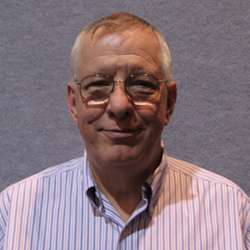
Burton J. Smith, an international leader in high-performance computer architecture and programming languages for parallel computers, as well as the co-founder of Seattle-based supercomputer company Cray Inc., died on April 2 at Regional Hospital in Highline Medical Center in Burien, WA, from complications of heart disease.
Smith grew up in Chapel Hill, NC, Albuquerque, NM, and Carpinteria, CA. He attended Pomona College in Claremont, CA, for a year before transferring to the University of New Mexico (UNM), which he attended briefly before leaving to join the U.S. Navy, where he worked on nuclear submarines.
He spent four years in the military before returning to UNM, where he studied electrical engineering, graduating summa cum laude with a BSEE degree. During his years as UNM, Smith met the woman who would be his wife for more than 40 years, Dorothy "Dottie" Smith.
After UNM, Smith went to the Massachusetts Institute of Technology (MIT) to pursue his doctorate; he received an Sc.D. degree there in 1972. Smith taught during his time at MIT, and after graduating, at the University of Colorado. He left that institution in 1979 for Denelcor Inc. in Aurora, CO, where, during his six years there, Smith was the primary architect of the Heterogeneous Element Processor, the world's first MIMD (multiple instruction, multiple data) computer, designed to solve fluid dynamics problems for the U.S. Army's Ballistic Research Laboratory.
From 1985 to 1988, Smith was a fellow of the Supercomputing Research Center of the non-profit Institute for Defense Analyses (IDA). With James Gottschalk, he co-founded Tera Computer Company, a maker of high-performance computer hardware and software, and from 1988 until 2005 he served as its chief scientist and a member of the board of directors (and was the company's chairman from 1988 until 1999). In 2000, Tera acquired the Cray Research unit from Silicon Graphics, and renamed itself Cray Inc.
In 2005, Microsoft hired Smith as a Technical Fellow; in that role, he worked with different groups in the areas of parallel and high-performance computing, as well as distributed services and quantum computing.
Smith received a number of awards during the course of his career, including the 1991 Eckert-Mauchly Award from the Institute of Electrical and Electronic Engineers (IEEE) and ACM, the 2003 Seymour Cray Computer Science and Engineering Award from IEEE, the 2010 IEEE Computer Society Charles Babbage Award. He was elected a member of the National Academy of Engineering in 2003, and named a Technical Fellow of the American Academy of Arts and Sciences in 2010. Smith was named an ACM Fellow in 1994 "For pioneering work in the design and implementation of scalable shared memory multiprocessors, and a Life Fellow of IEEE in 1994 for "for contributions to the design and development of scalable shared memory multiprocessors."
Arvind, Johnson Professor of Computer Science and Engineering in the Computer Science and Artificial Intelligence Laboratory at the MIT, said he got to know Smith "in 1979, soon after I joined MIT. In those days, Denelcor was in full swing and Burton practically lived in the airports and planes. I was surprised to discover a new soul who was as much into dataflow and as I was, and who had a strong connection to MIT and Jack Dennis. I also felt slightly deflated, because his HEP already had presence bits on every word of memory, while I was still trying to sell the idea of I-structures to the world. "
Arvind said Smith "loved meeting young people and had infinite capacity for discussion about computer architecture, compilers, mathematical puzzles, and new technologies. He told me about FPGAs, which I did not start using until 15 years later!
"We have lost a creative mind and a pioneer of parallel computing, and I have lost a true friend but I feel good that his legacy is secure."
William J. Dally, chief scientist and senior vice president of research at NVIDIA Corp., and professor (research) of electrical engineering and computer science at Stanford University, said Smith "was one of the great computer architects and was a pioneer in parallel computing."
Dally said he met Smith in the late 1980s "and had many interactions with him over a 30-year period on government advisory panels, and at HPC functions. I worked closely with him on Cray's DARPA HPCS project, and I regarded him as one of my mentors. Burton was very thoughtful and had a deep knowledge of computing. I learned something new every time I talked to Burton . He pushed the limits in the design of his machines, particularly with the HEP and the MTA, adding to our understanding of architecture in the process.
"The world is a less interesting place with his passing."
Andrew A. Chien, William Eckhardt Distinguished Service Professor at the University of Chicago, and editor-in-chief of CACM, said, "I had the good fortune to first meet Burton when I was a graduate student walking the corridors of MIT, and have a long relationship with him. I was continually astonished by his remarkable humility and approachability. He would listen thoughtfully to suggestions no matter how junior the speaker, and bring his encyclopedic knowledge to bear to bring out the good and promise hiding within the ideas. This quality made him a magnet for new thinking; Burton will be sorely missed."
Smith's wife predeceased him in 2015; he is survived by daughters Julia and Katherine (Ray), granddaughter Erin, and brother David.
Memorial services will be held May 19 at 2 p.m. at University Congregational United Church of Christ, 4515 16th Ave NE, Seattle, WA. Flowers and donations may be sent to the church.



Join the Discussion (0)
Become a Member or Sign In to Post a Comment